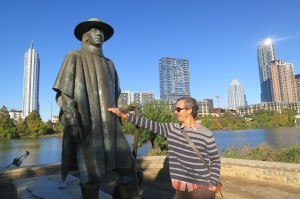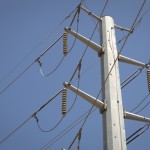Near-Catastrophe During Flooding Highlights Issues at Dam in Austin
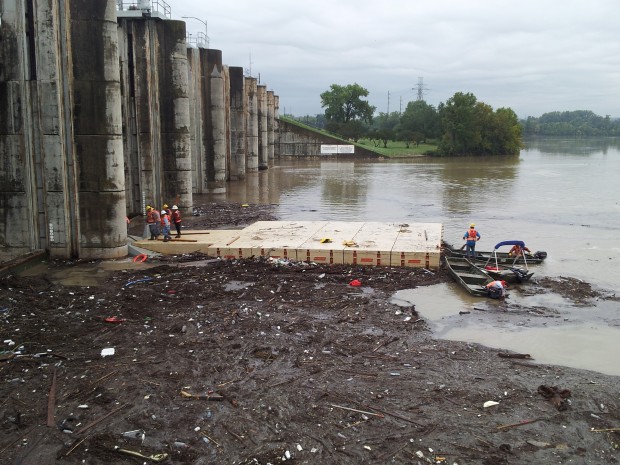
Austin Energy
Crews work to dislodge a barge from Longhorn Dam, the dam that creates Lady Bird Lake in downtown Austin.
A lot of people who walk or drive past Lady Bird Lake in downtown Austin probably assume it’s a natural feature. They appreciate the trails and parks that line the lake’s 416 acres, unaware of the series of floodgates on the Longhorn Dam that hold its waters in. But recent flooding along the waterway has called attention to longstanding mechanical problems at the dam, problems that the City of Austin is aware of, but hasn’t found the money to address.
While its been called the “jewel in the crown” of Austin, Lady Bird Lake was created to serve a utilitarian purpose: to provide water for a now-decommissioned gas power plant in the Holly neighborhood of East Austin. Because of its connection to the power plant, the dam is operated under the supervision of Austin Energy, the city’s publicly-owned electric utility. Built in 1960, the floodgates on Longhorn Dam have stored and released water from the lake for over 50 years. Now that age is showing.
“There’s been a lack of maintenance on the dam for the last 15 years,” Dennis Hipp, a recently-retired Austin Energy employee tells StateImpact Texas. “It’s steadily gotten worse and it’s to the point now where it’s going to start doing some damage. [Both] upstream and down.”
Hipp spent some of his 24 years at the Holly Power Plant operating the dam’s floodgates. He wanted to share his concerns in the hope that it would encourage the city of Austin to invest in repairs.
Now that the power plant is gone, there’s nobody close at hand to control the floodgates. Hipp says that’s a serious problem, because the gates need to be manually opened and closed in response to quickly changing water levels. Adding to the challenge is the fact that dam’s seven floodgates suffer from mechanical problems.
One of the gates is completely broken. It’s been sealed with a huge steel block called a “stop log,” a tool usually used for dam repairs. That reduces the amount of water than can be discharged from the Lake in times of flooding.
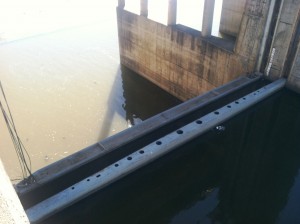
Mose Buchele
One floodgate is completely broken and has been blocked with a "stop log." This gate will not release water when it floods.
“That [stop log] is really just for maintenance,” Hipp says. “That’s not a permanent solution. And it’s been in there for probably six, seven years now.”
Other gates still open but are difficult to close, forcing work crews to improvise.
“Sometimes, they can take a stop log and they can bump, you know, one end of the gate or the other,” Hipp says. “They use it for weight.”
Much of what he describes is corroborated in two engineering reports Austin Energy commissioned. One was intended to provide a conceptual design and cost estimate for repairs to the dam (embedded below) the second report (provided by Austin Energy in “draft form,” and incomplete) was on the possibility of building a whole new dam.
Those reports say problems with the floodgates create a dual risk. They have contributed to flooding upstream, and created the possibility of the lake draining out if the floodgates don’t close.
Adding to all those challenges? The crews that control the gates during a flood are working in some of the worst possible conditions: amid heavy rain, winds and lightning.
“Most people in Austin just assume that [the gates] are automatic,” Hipp says. “Because it’s all done at night or in terrible weather where nobody’s out.”
That’s how it was the night of the Halloween floods.
Avoiding a ‘Catastrophe’
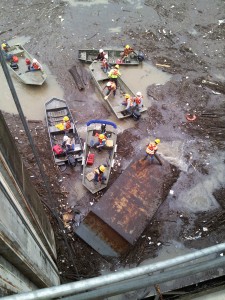
Photo Courtesy of Austin Energy.
Crews work to dislodge a barge from Longhorn Dam in Lady Bird Lake on Halloween 2013.
The problems that night aren’t connected to the flooding that took lives and destroyed homes elsewhere in Austin at Onion Creek, but they do show how difficult the situation has become at the Longhorn dam and can cause flooding downtown.
Communications obtained through an open records request from Austin Energy show that a work crew arrived at the dam to start opening gates around 11:10 p.m., right as the Lower Colorado River Authority (LCRA) began discharging water from Lake Austin upstream.
As heavy rains persisted, the LCRA released more and more water in Lady Bird Lake, reaching peak discharge at 1:25 a.m. About 20 minutes after that, work crews faced a challenge that, in the words of one Austin Energy Employee, brought them to the brink of “catastrophe.” Construction barges from the Lady Bird Lake Boardwalk project washed down the flood waters and into the dam. They jammed into two of the operable floodgates.
“It certainly complicated our operations that night,” Cheryl Mele, Chief Operating Officer at Austin Energy, tells StateImpact Texas. “At some points that night when we should have still had gates open, we did have to reduce the flows through the dam to make sure that we could secure and get those barges removed from the dam. So certainly that might have contributed a little bit [to the flooding].”
Outside of Austin Energy employees and emergency responders, there are few witnesses to the flooding on the lake. One of them was photographer Reagan Hackleman, who walked to Auditorium Shores when he heard the LCRA was releasing water downstream. He took the now-iconic photo of the flooded Statue of Stevie Ray Vaughn.
Hackleman says he watched the lake rise four or five feet in around 20 minutes, flooding César Chavez street and the lakeside park. That was around 2:30 a.m., approximately 40 minutes after the barges lodged in the dam.

Photo by Reagan Hackleman.
A statue of Stevie Ray Vaughn waist-deep in water, taken the night of the flood.
“When I took the picture, the water was up to my chest. And I’m a tall guy, I’m like 6-3,” he says.
Austin Energy COO Cheryl Mele agrees that the problem of the unmoored barges, coupled with the fact that one flood gate is sealed shut, did contribute to the buildup of water. Though she says that flooding would have happened even if everything had run smoothly.
“What we saw along Lady Bird Lake was the contributions of the LCRA needing to release water from Lake Austin, as well as the inflows coming in from Shoal Creek, and Waller Creek and Barton Creek,” Mele says. “Remember we were talking about unprecedented flooding levels.”
Data does show how more water was entering the Lake than was exiting. According to information obtained from an LCRA open records requests, the peak discharge of water from the Tom Miller Dam, upstream of Lady Bird Lake, was over 43,000 cubic feet per second around 1:25 a.m. The peak discharge of water downstream of the Longhorn Dam was around 34,000 cubic feet per second. Regardless of whatever other water was flowing into Lady Bird Lake, this suggests that Longhorn Dam was unable to handle the amount of water sent to it when the Tom Miller is discharging at peak capacity.
The fact that more water was entering the Lake than could exit, causes Dennis Hipp to conclude that much of the downtown flooding could have been avoided with better planning and a properly functioning dam.
“None of that downtown flooding had to happen,” he says. “Everything has to do with the dam, because if the water’s not going out, there’s no place for the creeks and ditches to drain to.”
Communications records show the sense of urgency late that night and into the morning. According to a log kept by the LCRA, Austin Energy crew called them to ask them what to do about the barges, saying they weren’t sure if they would be able to close the floodgates when they needed to. The LCRA advised they call the city’s emergency management department.
Eventually, around 9:25 in the morning, the team did free the obstructions with the help of contractors. But the troubles at the dam were not over.
Water Levels ‘Plummeting’
At 7:30 pm on Halloween evening, after the rains had ceased, the LCRA noticed that Lady Bird Lake, which earlier had flooded, was now draining – quickly.
According to the LCRA’s communications log, the agency contacted Austin Energy to say lake levels were – in their words – “plummeting.” Austin Energy replied that the flood gates had been closed and everything was under control. Seeing water levels continue to drop, LCRA called again, urging Austin Energy to make sure the gates were closed.
At 8:30 pm, Austin Energy called back to confirm that one floodgate on Longhorn dam had not closed properly. Austin Energy COO Cheryl Mele says that communications “weren’t as tight as perhaps they could have been.”
“[The gate] probably had debris under it, preventing it from going down and so we lifted it, let things flush and re-seated that gate,” she tells StateImpact Texas.
The problems with closing the gate echo challenges outlined in the engineering studies commissioned by Austin Energy, which say that equipment “frequently malfunctions” and that in the past the lift gates “have failed to open or close properly.”
An Acceptable Level of Flooding
The flooding that took place along Lady Bird Lake had a minimal impact compared to flooding elsewhere in Austin that night. Parts of Cesar Chavez street downtown were submerged – something that would not happen if the dam operated properly, according to one study. But in most places, the waters only flowed over parkland. Along the hike and bike trail, the worst damage discovered by StateImpact Texas was debris and dead fish left by the retreating flood waters.
Flooding has happened along the lake since before the dam was constructed, and Austin Energy’s Cheryl Mele says some flooding will always be a possibility in severe weather events.
“That’s one reason we do not have things along Lady Bird Lake, because there’s a flood plain,” she points out. As far as the dam is concerned, she says the maintenance problems do not threaten anyone’s safety.
According to one of the engineering studies, repairing Longhorn Dam would cost around $16 million. That’s money Austin Energy says it doesn’t have. And if the city did have that money, one could argue that it would be better spent on other flood remediation projects, like buying out houses in the floodplains of Onion Creek, where waters caused massive property damage and loss of life unrelated to the the operations of the Longhorn Dam.
“Would it be nice to have everything modernized? Sure,” Mele tells StateImpact Texas. “But it will take some planning to make sure that will be considered in future budgets. But there’s no urgent safety issues.”
In the absence of repairs, Austin Energy has been trying, unsuccessfully, to give control of the dam over to another group. The LCRA was approached about taking over operations, but the deal never went through.
For critics of the dam, like Dennis Hipp, each day that repairs aren’t funded is a day that brings the city closer to major flooding on the lake, or the surreal possibility of Lady Bird Lake draining out completely.
“Ever since I’ve started my career with Austin Energy, there’s always been issues with the dam. We’ve constantly sent emails, work orders, and nothing…” he says. “Just band aids have been put on it.”
